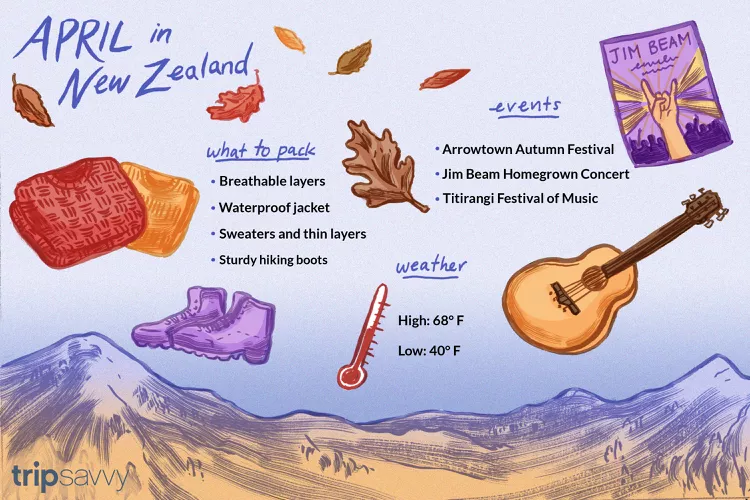Summary of April in New Zealand
April in New Zealand: A Guide for Travelers
While temperatures this month are a bit cooler than peak summer, April is among the best times to visit New Zealand. Considered a shoulder season, rates for travel and accommodation are much less than during summer’s peak travel season.
Moreover, New Zealand’s trees are changing, creating a colorful display, especially in regions such as Central Otago and Hawke’s Bay. Although New Zealand has no native deciduous trees, many European settlers brought species like oak and maple. As these trees shed their leaves during this season, they produce a stunning effect across various parts of the country. With cooler temperatures, this month is also ideal for hiking, fishing, and enjoying the outdoors.
New Zealand Weather in April
Temperatures become noticeably cooler in April. Both the North and South Islands enjoy sunny days with pleasant daytime highs that drop during the night. Typically, the further south you go, the lower the temperatures will be.
- Auckland: 68°F (20°C) / 55°F (13°C)
- Wellington: 62°F (16°C) / 51°F (11°C)
- Christchurch: 63°F (17°C) / 44°F (7°C)
- Queenstown: 59°F (15°C) / 40°F (4°C)
As weather patterns shift, conditions can be quite variable, with occasional stormy and rainy periods. In general, however, April is one of the more stable months, although “settled” can be a relative term due to New Zealand’s maritime climate.
April typically sees moderate rainfall, with cities like Auckland, Wellington, and Queenstown receiving around 3.5 inches for the month. (Christchurch is slightly drier, with only 1.8 inches of rainfall in April.)
In summary, New Zealand is exceptionally sunny in all seasons, with most regions receiving over 2,000 hours of sunshine annually. UV rays here are strong, so it is still possible to get sunburned into late April; hence, preparation is crucial.
What to Pack
Regardless of the season, New Zealand’s unpredictable weather means maintaining a consistent packing list. In April, which is fall in New Zealand, the temperatures are cool but not frigid; jeans paired with a sweater are suitable in most areas of the country. However, you should consider packing the following essentials:
- T-shirts and breathable base layers
- Medium-weight sweaters or sweatshirts
- A waterproof jacket
- Jeans
- A pair of non-denim pants or trousers
- Warm socks for chilly nights
- Sturdy hiking boots or waterproof footwear
April Events in New Zealand
Fall is prime time for unique New Zealand events that showcase the country’s rich history, culture, and sports.
- Anzac Day Dawn Service: This solemn event occurs on April 25 at the Auckland War Memorial Museum, commemorating the sacrifices of those who served in War.
- The Jim Beam Homegrown concert: This vibrant music festival takes place in Wellington in early April and draws over 40 local acts across five stages.
- Arrowtown Autumn Festival: Taking place in Christchurch, this multi-day celebration features everything from street performers to parades, variety concerts, and barbershop quartet competitions.
- Titirangi Festival of Music: This annual non-profit event celebrates New Zealand’s unique music scene and culture, typically held in Auckland in early April or late March.
- Softbait Fishing Championship: This competitive event mirrors a bass fishing tournament in the U.S. Anglers are judged on the number of fish caught, rather than the weight. This championship occurs in Coromandel during early April.
- Warbirds Over Wanaka: Known as one of the best air shows globally, this annual event combines vintage and veteran aircraft with machinery displays, fire engines, and more, usually scheduled over Easter weekend.
April Travel Tips
- April showcases fall colors at their peak; however, it’s a low season for tourism, meaning fewer crowds.
- Unfortunately, the cooler weather isn’t ideal for watersports, but a few northern beaches, such as Pakiri Beach near Auckland, remain warm enough for swimming.
- Daylight saving time in New Zealand concludes on April 7, resulting in shorter days with less available daylight.




